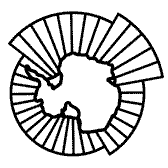Related Research Articles

The Ross Sea is a deep bay of the Southern Ocean in Antarctica, between Victoria Land and Marie Byrd Land and within the Ross Embayment, and is the southernmost sea on Earth. It derives its name from the British explorer James Ross who visited this area in 1841. To the west of the sea lies Ross Island and Victoria Land, to the east Roosevelt Island and Edward VII Peninsula in Marie Byrd Land, while the southernmost part is covered by the Ross Ice Shelf, and is about 200 miles (320 km) from the South Pole. Its boundaries and area have been defined by the New Zealand National Institute of Water and Atmospheric Research as having an area of 637,000 square kilometres (246,000 sq mi).

The gastropods, commonly known as snails and slugs, belong to a large taxonomic class of invertebrates within the phylum Mollusca called Gastropoda.

Nudibranchs are a group of soft-bodied, marine gastropod molluscs which shed their shells after their larval stage. They are noted for their often extraordinary colours and striking forms, and they have been given colourful nicknames to match, such as "clown," "marigold," "splendid," "dancer," "dragon," or "sea rabbit." Currently, about 3,000 valid species of nudibranchs are known.

The Convention on the Conservation of Antarctic Marine Living Resources, also known as the Commission for the Conservation of Antarctic Marine Living Resources, and CCAMLR, is part of the Antarctic Treaty System.

The clade Anaspidea, commonly known as sea hares, are medium-sized to very large opisthobranch gastropod molluscs with a soft internal shell made of protein. These are marine gastropod molluscs in the superfamilies Aplysioidea and Akeroidea.

Sea slug is a common name for some marine invertebrates with varying levels of resemblance to terrestrial slugs. Most creatures known as sea slugs are actually gastropods, i.e. they are sea snails that over evolutionary time have either completely lost their shells, or have seemingly lost their shells due to having a greatly reduced or internal shell. The name "sea slug" is most often applied to nudibranchs, as well as to a paraphyletic set of other marine gastropods without obvious shells.

Dissostichus, the toothfish, is a genus of notothen found in the Southern Hemisphere. Toothfishes are marketed in the United States as Chilean sea bass or less frequently as white cod. "Chilean sea bass" is a marketing name, coined in 1977 by Lee Lantz, a fish wholesaler who wanted a more attractive name for selling the Patagonian toothfish to Americans. In 1994, the U.S. Food and Drug Administration (FDA) accepted "Chilean sea bass" as an "alternative market name" for Patagonian toothfish. The toothfish was remarkably successful in the United States, Europe and Asia, and earned the nickname “white gold” within the market. Toothfishes are vital to the ecological structure of Southern Ocean ecosystems. For this reason, on 4 September a national day is dedicated to the toothfish in South Georgia.
Curnonidae is a small family of sea slugs, nudibranchs, shell-less marine gastropod molluscs, in the clade Euthyneura.
Quadrangularis means "quadrangular" in Latin. Quadrangularis is the species name in the binomial nomenclature of several species:
Hallaxa iju is a species of sea slug or dorid nudibranch, a marine gastropod mollusk in the family Actinocyclidae.
Gulenia borealis is a species of sea slug, an aeolid nudibranch, a marine gastropod mollusk in the family Flabellinidae.
Notaeolidia depressa is a species of sea slug, an aeolid nudibranch, a marine gastropod mollusc in the family Notaeolidiidae.
Notaeolidia gigas is a species of sea slug, an aeolid nudibranch, a marine gastropod mollusc in the family Notaeolidiidae.
Pseudotritonia is a small genus of sea slugs.

Nerida Gaye Wilson is an invertebrate marine molecular biologist at the Western Australian Museum who has interests in diversity, systematics, phylogeny, phylogeography and behavior. Wilson has been instrumental in demonstrating the level of marine cryptic species complexes in Antarctic waters, testing the circumpolar distribution paradigm with molecular data, and using interdisciplinary approaches to show how Antarctic diversity may have been generated. Her work with NOAA on Antarctic Marine Living Resources has been used to regulate exploratory benthic fisheries.
Pseudotritonia gracilidens is a species of sea slug, a dorid nudibranch, a shell-less marine gastropod mollusk in the family Curnonidae.

Funiculina quadrangularis, commonly known as tall sea pen, is an uncommon cold water coral within the Family Funiculinidae. It is named tall sea pen because it looks like a quill sticking in the bottom of the sea. It forms habitat for several key crustacean species.

Crosslandia is a genus of sea slugs, in the family Scyllaeidae. Members of this genus inhabit areas such as the Pacific coast of central America, and the Indo-West Pacific.
The Register of Antarctic Marine Species, also known as RAMS, is a taxonomic database that provides a list of marine species found in the Southern Ocean surrounding Antarctica.
Tritoniella is a genus of sea slugs, specifically dendronotid nudibranchs. It is a marine gastropod mollusc in the family Tritoniidae. A monotypic genus, the only species is Tritoniella belli. The genus and species were both described in 1907 by the British diplomat and malacologist Charles Eliot.
References
- ↑ "WoRMS - World Register of Marine Species - Pseudotritonia quadrangularis Thiele, 1912". www.marinespecies.org. Retrieved 2019-03-27.
- ↑ jurisdiction=New South Wales; corporateName=Australian Museum; author=Rudman, W. B. (2010-07-15). "The Sea Slug Forum - Pseudotritonia quadrangularis". www.seaslugforum.net. Retrieved 2019-03-27.CS1 maint: multiple names: authors list (link)
| | This gastropod-related article is a stub. You can help Wikipedia by expanding it. |